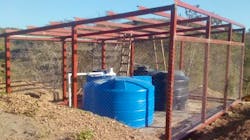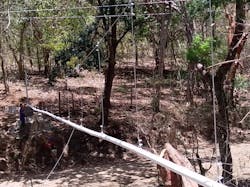Boosting Water Supply in Rural Nicaragua
In 2014, the Colorado School of Mines chapter of Engineers Without Borders (EWB-Mines) began a seven-year-long journey to provide clean water access to a small rural community in Nicaragua. The community of Los Gómez is situated in southwestern Nicaragua. Like many communities in low- and middle-income countries (LMICs), community members in Los Gómez face water shortages year-round.
Access to clean water is one of the Sustainable Development Goals identified by the United Nations. Recently, many groups and organizations have attempted to create solutions to improve clean and healthy water access. Yet, as with any community development project, no universal solution exists. EWB-Mines worked through the inherent technical and social issues that any community development project must face, along with more challenging issues such as travel bans. To overcome these challenges, EWB-Mines forged various local partnerships.
The first partnership was established between the EWB-Mines team and the Los Gómez community. In 2014, the community and EWB-Mines selected a water distribution system to follow the construction of a nearby bridge. In Los Gómez, a town of 220 people, most community members are left without basic access to drinkable water despite artisanal wells scatted throughout the community. To develop a design, the EWB-Mines team traveled to Los Gómez several times to collect data and receive community feedback on their plans. The EWB-Mines team developed a rough outline and timeline early on. EWB-Mines also established a cost- and labor-sharing agreement with the community. EWB-Mines would provide 95 percent of the materials costs (funded by the Westminster 7:10 Rotary club of the eRotary District 5450), and community members would donate their labor to the construction process.
After drilling the well in 2017, EWB-Mines planned to travel and collect more data the following summer. However, 2018 brought political unrest in Nicaragua, resulting in canceled travel plans and delayed progress. During this time, EWB-Mines relied more heavily on their second key project partner: the local EWB country office in Managua. This close collaboration kept the project moving in 2020, when travel plans were again disrupted due to the COVID-19 pandemic.
In light of travel restrictions, Engineers Without Borders-USA recommended remote implementation. However, without boots on the ground, the poorly understood geography of Los Gómez began to present a design problem to the team. Houses in the community are divided across two hillsides. Many homes are located along a gully periodically used as the main road. The community layout made it difficult to resolve pressure and flow issues as the pipeline ran down on one hillside and up to houses on the other, traversing a difference in elevation of over 200 feet (60 m). Several suspension crossings designed in a cost-effective yet durable manner were also necessary to cross the gully.
In addition to the challenging geography, insufficient local internet and cell service often impeded effective communication with Los Gómez community members. Without frequent contact, obtaining community feedback on design decisions and keeping the community informed on developments proved difficult. However, EWB-Mines’ partnership with the local EWB country office allowed the team to work around these challenges. The country office offered vital help by collecting data, performing surveys, and arranging meetings with the community. The country office was also able to provide relevant and culturally informed advice at every turn. Similarly, the country office was instrumental in working with the community to resolve disputes and formalize the system’s long-term management. The EWB-Mines team could have never accomplished this alone.
By the end of 2020, EWB-Mines was able to put together a complete design and construction plan. The final system consisted of a distribution network providing fresh water to 50 households spread out across 15,000 feet (4,500 m) of pipeline. The groundwater is pumped from a well depth of 250 feet (75 m). Then the water is subsequently stored in two, 1,250-gallon (5,000 L) chlorinated storage tanks at an elevation over 1,000 feet (300 m). The pipeline branches in several locations and includes eight sections of supported stream crossings. Taps stands are located at each household and include meters used to charge residents a monthly fee. The EWB-Mines team designed the system to recover sufficient pressure to achieve a community-wide flow rate of nearly 1.5 GPM (5 LPM). Pressure relief valves (PRVs) would be carefully calibrated and installed throughout the system to prevent over-pressurizing the joints in the pipeline network.
With the design work done, EWB-Mines formed their third partnership in December 2020 with Santiago Betanco, a professional Nicaraguan engineer with extensive construction experience. Betanco had previously executed similar community-based water distribution projects. Without Betanco’s expertise, the team would have struggled to overcome the many surprises that presented themselves during construction. Betanco was flexible and decisive when the need to suddenly re-route sections of the pipeline arose. He was also able to draw up quick designs when the alternative pipeline location resulted in five new stream crossings. His knowledge of local construction practices and creative design adaptations meant that the project only faced minor delays. The construction of the distribution network was completed in late March 2021.
However, the completion of the distribution system only addresses half the goal of providing access to clean water. In the longer term, maintaining high water quality is another complicated challenge.
The feats accomplished together by the EWB-Mines team, the EWB country office in Nicaragua, and the talented experts in Nicaragua underscore the significance of partnerships in humanitarian development work. It is not a matter of foreign aid but a matter of working toward a collective future as a global society. Additionally, by partnering with local organizations, the project is more likely to be sustainable in the long term as there is decreased reliance on foreign assistance. Today, EWB-Mines anticipates a future monitoring and evaluation (M&E) trip. Seeing the distribution system up and running in person will be a much-celebrated sight after these years. WW
About the Authors: Madison Berry has been a project lead for the EWB-Mines project in Nicaragua for the last two years. She graduated in May 2021 from the Colorado School of Mines with a bachelor’s degree in mechanical engineering and a minor in engineering for community development. Her interest lies in the WASH field and she hopes to work in international development after graduation.
Florian T. H. Kleinhoven is soon graduating with a master’s degree in environmental engineering from Newcastle University in the U.K. He also works for EcoSwell, a renewables NGO in Peru, and mentors the EWB-Mines team for the Los Gómez water distribution project.
About the Author
Madison Berry
Madison Berry has been a project lead for the EWB-Mines project in Nicaragua for the last two years. She graduated in May from Colorado School of Mines with a bachelor’s degree in mechanical engineering and a minor in engineering for community development. Her interest lies in the WASH field and she hopes to work in international development after graduation.
Florian T. H. Kleinhoven
Florian T. H. Kleinhoven is soon graduating from a master’s degree in environmental engineering from Newcastle University in the U.K. He also works for an EcoSwell, a renewables NGO in Peru, and mentors the EWB-Mines team for the Los Gómez water distribution project.


